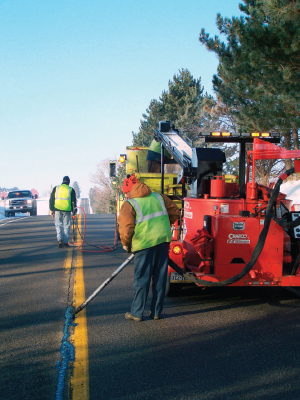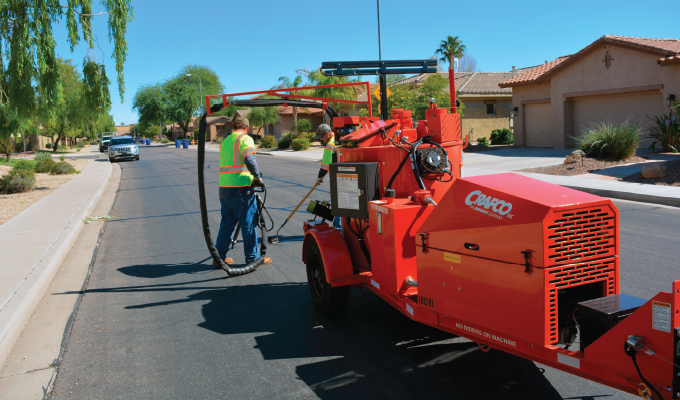For many regions of the country, freezing winter temperatures keep sealcoating contractors and pavement maintenance professionals cooped up, unable to get out onto the pavement. As temperatures begin to rise, so do the number of calls seeking repair to the damage winter left behind. For sealcoating contractors waiting for the ideal weather conditions to begin sealcoat work, crack sealing work provides a great opportunity to be able to start bringing in income sooner to your business after the long winter.
WEATHER’S EFFECT
Asphalt, like nearly all materials, experience some measure of thermal stress as the material is either heated or cooled. During cold winter temperatures, asphalt pavement contracts and any cracks present, open to their widest. Conversely, during hot summer temperatures, asphalt pavement expands and any open cracks, close. The spring season offers more moderate temperatures that tend not to reach the extremes temperatures of winter and summer weather. Spring is a perfect time to seal cracks. The cracks are still open enough to apply the sealant into the crack before the warm summer weather comes and the cracks are narrowed.
Cracks are inevitable. When cracks form, water seeps in and under the asphalt pavement, causing deterioration. No matter the season, contractors and pavement maintenance professionals must be certain crack repair operations are only performed in dry conditions. Any moisture present in the pavement or crack will prevent adhesion of the material to the walls of the crack, increasing the likelihood of failure.

CRACK SEALING
Sealing cracks in a timely manner is one of the most effective ways to maintain the quality of your pavement. According to a group study conducted by the National Center for Asphalt Technology (NCAT), “crack sealing and filling are cost-effective treatments that provide life-extending benefits when applied to pavements in good, fair, and poor conditions.” The process of crack sealing is different from the process of crack filling for several reasons.
Asphalt pavement is referred to as a flexible pavement that moves horizontally due to changes in temperature and may move vertically as a result of traffic loads. Some cracks can open to 100% of original width as the pavement temperature changes from summer to winter extremes. Crack sealing uses specialized material that will adhere to the pavement and retain the seal as the pavement moves. High quality sealants designed for specific climate in your area and good application practices assure the crack sealing will prevent the intrusion of water and prevent further deterioration of the pavement.
HOT-APPLIED CRACK SEALING
Warmer weather, longer days, and reduced rainfall— certainly spring is the optimum season for crack repair. But winter can also be a good time to crack seal.
One advantage of sealing in the winter is that cracks are already open and can be sealed more easily. When most types of preventive maintenance and preservation techniques are unable to be performed due to water composition (emulsion-based), the availability of supplies or a material’s inability to cure—crack sealing can still be performed with hot-applied crack sealant.
Crack sealing can be performed in virtually any outside air temperature so long as the crack is dry and warmed to 40-degrees F, which is achieved with relative ease via a hot air lance.
It might not be the ideal time to start sealcoating, but crack sealing done in the winter or spring allows sealcoat contractors the ability to start work earlier.
CRACK SEALING TIPS
Crack routing. Routing is important for two specific reasons: (a) routing cleans the crack and creates uniform and fresh edges to allow the sealant to adhere better with the pavement and (b) a designed routed reservoir filled with crack sealant has the amount of sealant to expand and contract with the seasonal movement of the pavement. In addition, the sealant is at the right depth below the surface of the pavement to protect against traffic and snowplow contact. Routing requires an additional piece of equipment, and while it adds costs to any crack sealing operation, research has shown routed crack repairs are cost-effective and last over twice as long as non-routed crack repairs.
Crack cleaning and drying.
Whether a decision to rout is made or not, or a decision to seal or fill is made or not; it is essential to provide a clean, dry crack channel to remove any loose material from the crack. Cracks that are damp, contain debris, vegetation, or loose aggregate or sand, will fail because the sealant won’t be able to adhere to the crack walls. Cleaning consists of using dry, clean, high-pressure compressed air, brushing, or vacuuming to remove debris. When there is moisture, clay, or vegetation you will want to use a hot air lance. Use caution not to burn the crack.
Material preparation.
Contractors and pavement maintenance professionals should be sure to follow minimum placement temperatures, minimum and maximum material heating temperatures, application life (hours material is in melter), and recommended moisture conditions prior to application.
Material placement.
Apply material when the pavement exceeds the minimum pavement application temperature, which is generally 40-degrees F. Cracks must be dry and free from ice and other contaminants. Be sure the sealing or filling operation moves at a steady pace. The melter/applicator should monitor the temperature and quantity of material as over or under heating the material can delay the entire application.
Blotting.
Blotting protects the uncured crack treatment from tacking under traffic and is used in areas where traffic needs to travel on the material before it cures. Cement powder, talcum powder, lime, sand, and limestone chips are common blotting materials. Proprietary detackifying products designed specifically for blotting crack repair material are also available.
CLOSING THOUGHT
Crack sealing is proven to be the lowest-cost, highest benefit preservation treatment, providing life-extending benefits when applied to pavements in good, fair, and poor conditions. It’s also a way for sealcoating contractors to extend the work season and bring in income while they waiting for the sealcoating season to begin .
For More Information:
For more about Crafco’s hot-applied sealants and equipment for crack sealing, visit crafco.com.
Modern Contractor Solutions, January 2022
Did you enjoy this article?
Subscribe to the FREE Digital Edition of Modern Contractor Solutions magazine.



